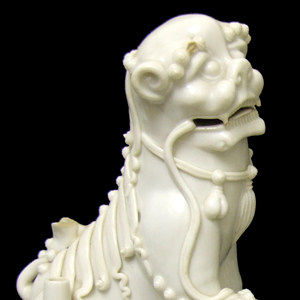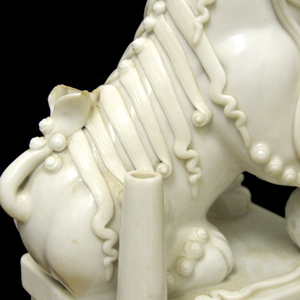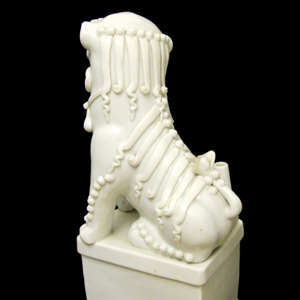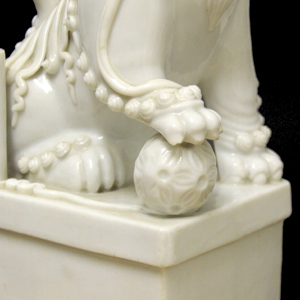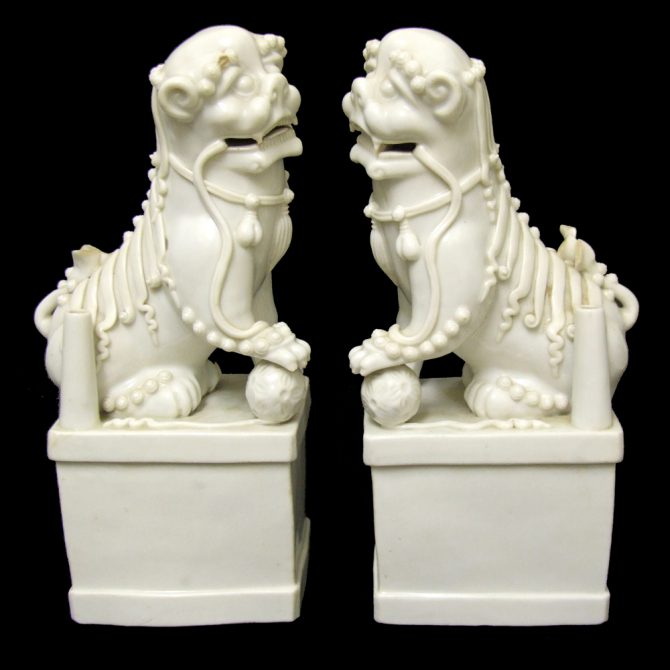
SHUNZHI or KANGXI c.1640 – 1700 Blanc de Chine Porcelain
A Pair of Shunzhi or Kangxi Blanc de Chine Porcelain `Dogs of Fu` Taper-Stick Holders, from a Kiln in Dehua Fujian Province c.1640-1700.
SOLD
- Condition
- Left Lion : Chips to the end of the tail, one chip to a curl above the left eye. Right Lion : Chips to the end of the tail, 3 mm crack to the taper-stick holder, a long crack to the center of the chest, this is probably on the lutting-line, a fine crack to the left of the lions eye, a minute crack to one curl on the eye.
- Size
- Height : 26.3 cm (10 1/2 inches).
- Provenance
- N/A
- Stock number
- 21903
- References
- To see a related Blanc de Chine `Fu dog` from the Hatcher Cargo, datable to circa 1643 look at stock number 19961 in our `Sold` items. For a very similar pair of male Blanc de Chine `Fu Dogs` which have been dated to c.1640 see : Blanc de Chine (John Ayres / Richard Marchant. S.Marchant and Son, 2006. London) page 49, item 56, where the author states that a similar piece in the Dehua Museum comes from a Ming Dynasty tomb. A pair dated to late Ming or early Qing are illustrated in : Blanc de Chine, Divine Images in Porcelain (John Ayres, China Institute Gallery, New York, 2002) page 98, plate 49. For another very similar single Buddhist Lion, dated as mid-17th century see : Blanc de Chine, Porcelain From Dehua. A Catalogue of the Hickley Collection (Rose Kerr & John Ayres, Art Media Resources Ltd 2002) plate 91. For a further pair of male Blanc de Chine lions dated to c.1650 -1700, inventoried in 1701, see : Blanc de Chine (P.J Donnelly, Faber and Faber, 1969) plate 93. For a pair of similar male Blanc de Chine lions see our `Sold` items stock number 20344.
Information
Blanc de Chine Porcelain `Dogs of Fu` :
Blanc de Chine Fu Dogs are difficult to date, they were made in the provincial kilns of Dehua in Fujian province. There are very many versions, all of which are rather similar but really following the same basic model. Technically the production didn`t change much either, on the whole the earlier models have more hand-working. However, the early Blanc de Chine Fu dogs from the Hatcher Cargo, datable to circa 1643 ( stock number 19961 ) have little hand-work. The potting, glaze colour and general finish all point to a specific period but accurate dating is, I believe, very difficult.
As with most pairs of Blanc de Chine Fu Dogs the pair are not a pair in the way we know it today. For a start, both are male as they have a brocaded ball each. Only one has a nozzle to take a taper-stick. These would, I am sure, have been a pair originally, the colour, construction and especially the faces are very similar, although only one has his tongue sticking out.
Dogs of Fu :
Interestingly, the lion is not indigenous to China. When Buddhist priests, or possibly traders, brought stories to China about stone dogs guarding the entry to Indian Buddhist temples, Chinese sculptors modelled statues after native dogs for use outside their temples. The mythic version of the animal, was known as the Dog of Fo, the word Fo being Chinese for Buddha. (Compare the Chow Chow, Pekingese, Shi Tzu, Shar-Pei, and Pug breeds.)
The Buddhist version of the dog was originally introduced to Han China as the protector of dharma and these dogs have been found in religious art as early as 208 BC. Gradually they were incorporated as guardians of the Chinese Imperial dharm. However, Chinese sensitivity metamorphosed the dog into a lion, since this seems more appropriate to the dignity of an emperor when he used the beasts to guard his gates.
The mythic dog is sometimes associated with feng shui, and are often called Fu Dogs. Fu means `happiness` in Chinese; however, the term "Fu Dog," and its variant Foo Dog, are not used in Chinese. Instead, they are known as Rui Shi("auspicious lions") or simply Shi ("lions").
There are various styles of imperial guardian lions reflecting influences from different time periods, imperial dynasties, and regions of China. These styles vary in their artistic detail and adornment as well as in the depiction of the lions from fierce to serene.
